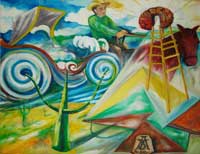NOTION AND CONDUCTION
LOTSE-COACHING IS TO FACE SOLUTIONS AND RESULTS.
 The solution and the vision of solution, and with that the imaginary success (as if it had happened) is in the first plane in the process of training and not the diagnosis of the problem, to activate its reserves. The results happen by oral interventions and the direction of questions (you ask which are the reins the horses are led with that act like ¨ neuronal projectors ¨ and who often displace the trained to a solution of fluency.
The solution and the vision of solution, and with that the imaginary success (as if it had happened) is in the first plane in the process of training and not the diagnosis of the problem, to activate its reserves. The results happen by oral interventions and the direction of questions (you ask which are the reins the horses are led with that act like ¨ neuronal projectors ¨ and who often displace the trained to a solution of fluency. For the passing and the temporary limited experimental transfer of solution and actions of success will be new the fulfillments of emotional results, the behavior is moderated and it is located at a brain level. Also a positive knowledge of behavior happens during life with experiences of imaginary successes of positive sensations in every sense . For the reactions of positive experiences in itself and other changed reactions of the systematical environment the way is consolidated to short steps towards success. At least during the phase of training it is lived with emotion and vision of the experienced success. The thing is that it does not go beyond ¨yes ¨, but about ¨how ¨ it lives through success and change for my emotional behavior and later I moderate my status. The trained one must take at once ¨the rudder ¨ of his life.
CLARIFICATIONS OF WORDS.
The pilot comes on board.
Consequently the image of the pilot serves very well as presentation and with him the association of ¨LOTSE - COACH ¨ ( pilot-client). He comes on board to accompany the expert in the impetuous swell along his life, passing for the right direction between the dangerous reefs and low floors, the pilot guides it to sure port.
In this metaphor (LOTSE) comes originally from the navigation Loadsman = Geleitsmann =.driver
Pilot (LOTSE) is in the navigation the majority of times captain, commander, expert, with practical experience, which knows well certain waters the one who can accompany the chiefs of ships for low floor along the trip.
As the ship comes from training, the trainer as pilot gives continuity to difficult situations in the time that he is on board. The captain in COACHING keeps ¨the rudder ¨ of his life and the responsibility of the ship.
With this LOTSE-COACH accompanies the client on intervention questions abaut unknown waters and makes sure that the client can take it , finally, to the port.
This way the client can obtain his future solutions. His progressive and independent development could be identified by him.
THE CONCEPT OF COACHING ITS HISTORICAL CONDUCTION. (Also for LOT-COACHING + BORD)
 IMAGES OF COACHING PYRAMID PAINTING IN THE CARRIAGE .
IMAGES OF COACHING PYRAMID PAINTING IN THE CARRIAGE .The English concept of ¨Coach ¨ comes originally from the name of a Hungary {village} called Kocsi Szeker. There the horses were particularly beautiful calling them the cars of Kocs ¨ they were made in the XVth century. Then this expression was transforming into the short one ¨kosci ¨. In the XVIth century this word was appearing in the European cultural language, in German as carriage , in French car, in Italian ¨cocci ¨,in Pole ¨kocz ¨,in flamenco ¨goetze ¨and, in Swedish as ¨kush ¨.
Since 1556 this expression found the entry in the use of the English language as¨Coach ¨.
Then, making to start the carriage is to accustom a horse to pull a car, ¨to coach a horse ¨. Approximately since 1579 the word ¨coach ¨ or ¨coachman ¨ was also the person who guided and took care of the horses.
Today the word ¨coach ¨ for people , finds in the British linguistic space, the use of the car or inter-city bus.
The carriage image indicates the training nucleus : The carriage is a way of help, a way of transport, to set out and to reach the objetive .
THE HISTORICAL SUMMARY AND IMPERIAL TRADITIONS OF THE TRAINING COACHING.
In the trainings the powerful men always had a personal adviser.In ancient times Kings and emperors were surrounding themselves with their advisers.
COACHING is not a new notion.
Today presidents or heads of the states are not conceived without an adviser.
Other subdivisions of ideas develoment of training to use new áreas .
The expresión ¨Coach ¨ was going out in 1848 for the first time in the British Universities and was referring to a teacher who takes care individually. Little by little ¨Coach ¨ was named as a teacher of help privately, or a repeater who prepares for examinations or special tasks, also since 1861 ¨Coach ¨ is synonymous for sports trainer.
The guarantor is increasingly in the sports area ” The trainer who accompanies and advises the sportsman, takes care and motivates him earlier, during and after the sports contest. The person was already qualified by then of ¨Coachee ¨. the origin and area of principal employment of ¨Coaching ¨is until the 60s of the XXth century where is located in the sport of high class. There it is understood by the ¨Coach ¨ as a wide, professional and psychological attention of the yield of the sportsman or the team.
The importance and diffusion of training in sports area grew further in the 60s of the XXth century. The mental psychic stability is as important as the corporal sports one. Consequently the trainings happen the majority of the times as mental-psychic attention for the sportsmen for formed advisers psychologically or personal trainers.
Finally the ideas transfer of the training in the management field and personal development was happening since 1970 in USA and since 1980 in Germany. Today, the one who wants to be a part in the game, in an encompassed world names his trainer adviser of life,as long as each one wants to be favored like the Manager or the teacher of children education.
METAPHOR AND VISUALIZATION OF THE COACHMAN MODEL AND IMAGINATION OF TRAINING (COACHING).
The process of training COACHING can present oneself as a carriage. The Coachman (Coach) has the reins in his hands and guide the car with questions. The horses (Coachee or clients) are competent to guide the car. The coachman has to guide the task the horses, find the right way with questions and help: With this the Coach guide meets to check a subjective map to the client, who makes him ponder and influence his actions and thoughts, transmits the situation of training and the client has at the end the reins in his hand,he knows the way and the possible directions. Up to there it is the help of the Coach. It is important that the client always finds for himsell the solution or the way. The Coach must never exercise hiswisdom , but only he must offer help to the client for his own defense.
A problem that possibly can appear is the authoritarian, not clarified question, between the Coach and the client.
1. Kessel, L. the v. (2002)th. Coaching im Bild? Seite 137, in A. Strau ß and P. Awecker (Hg.), Coaching (Bd.4, Century 137-164). Innsbruck: Studien-Verlag. ↑
2. Bayer, H. (1995). Coaching-Kompetenz. Persönlichkeit und Führungspsychologie. Seite 94 München: Reinhardt Kessel, L. the v. (2002)th. Coaching im Bild? In A. Strau ß and P. Awecker (Hg.), Coaching (Bd.4, Century 137-164). Innsbruck: Studien-Verlag. ↑
3. Kubowitsch, K. (1995). Seite 243 Power Coaching wie Sie sich besser vermarkten und mehr Einfluss im Unternehmen gewinnen. Wiesbaden: Gabler ↑
4. Kubowitsch, K. (1995). Seite 243 Power Coaching wie Sie sich besser vermarkten und mehr Einfluss im Unternehmen gewinnen. Wiesbaden: Gabler ↑
5.vgl. ebenda, Seite 243 ↑
6. Rauen, C. (1999) .Seite 20 Coaching innovative Konzepte im Vergleich. Göttingen: Verlag für Angewandte Psychologie ↑
7. Backhausen, W. and Thommen, J. (2003). Seite 18 .Coaching. Durch systematisches Denken zu innovativer Personalentwicklung. Wiesbaden: Gabler. ↑
8. Der Begriff give Coaching ist deshalb mit dem Personalmanagement und dem Führungsmanagment verbunden ↑
9. Rauen 1999, Seite 22 sowie Die Zeit Nr. 35 vom 21.8.2008: You give gecoachte Ich ↑ 10. Frage-Zügel als neurologische Scheinwerfer “ = werfen Licht auf die noch dunklen Flecken im Inneren eines Menschen, damit er auch give dort Verborgene erkennt und so zu neuen Ideen und Lösungen kommt.
 Deutsch
Deutsch Español
Español English
English
